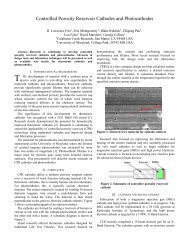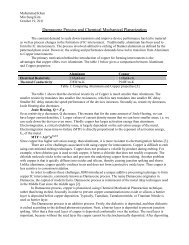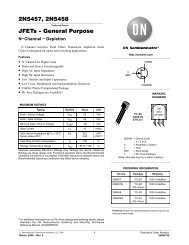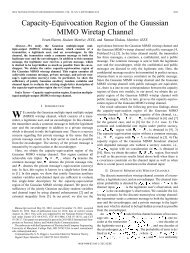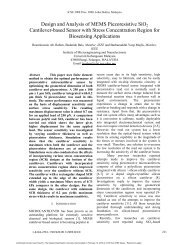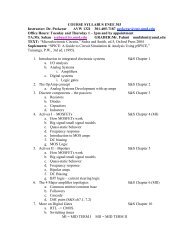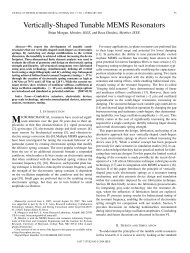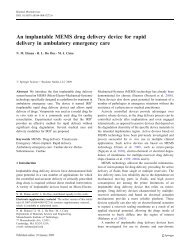A BioMEMS Review: MEMS Technology for Physiologically - ECE ...
A BioMEMS Review: MEMS Technology for Physiologically - ECE ...
A BioMEMS Review: MEMS Technology for Physiologically - ECE ...
Create successful ePaper yourself
Turn your PDF publications into a flip-book with our unique Google optimized e-Paper software.
layers with thin layers of PU precursor in between to act as<br />
glue. The authors envision fabrication of different trabecular<br />
bone scaffolds (plate-like, hybrid, and rod-like) by varying<br />
the microchannel structure. These scaffolds could be seeded<br />
with cells <strong>for</strong> implantation. Others are investigating the<br />
use of silicon scaffolds <strong>for</strong> hepatocyte culture [143]. Deep<br />
reactive ion etching (DRIE) is used to <strong>for</strong>m micropores in<br />
a 230- m-thick boron-doped silicon wafer. This wafer is<br />
sandwiched between two coregistered array plates, seeded<br />
with primary rat hepatocytes, and contained in a reactor<br />
housing. Tissue culture medium is perfused through the<br />
reactor. Reactors that were seeded with hepatocyte spheroids<br />
(preaggregated cells), showed the <strong>for</strong>mation of tissue-like<br />
structures that maintained their structure and viability<br />
<strong>for</strong> up to the two weeks of the study. This represents an<br />
improvement over typical in vitro cell culture conditions,<br />
under which hepatocytes rapidly lose their liver-specific<br />
functions. Finally, another notable endeavor is the use of<br />
silicon micromachining and polymer replica molding to<br />
produce scaffolds <strong>for</strong> vascular tissue [144]. In vitro engineering<br />
of complex tissues and organs is often limited by<br />
the lack of an intrinsic blood supply. Tissue thicknesses<br />
of greater than 1–2 mm are sufficient to cause significant<br />
cell death, as oxygen from the surrounding tissue culture<br />
medium cannot diffuse far enough into the tissue to support<br />
cells in the interior of the tissue construct. The use of microfabrication<br />
techniques to engineer a microvasculature <strong>for</strong><br />
organs and tissues requiring a blood supply is one possible<br />
route to address this problem. Standard microfabrication,<br />
photolithography, and plasma etching techniques can be<br />
used to pattern a vasculature pattern developed through<br />
evolutionary fluid dynamic design into a silicon wafer.<br />
Replica molding can then be used to create a PDMS or poly<br />
(lactic-co-glycolic acid) (PLGA) microfluidic network. Two<br />
microfluidic sheets can be bonded together to <strong>for</strong>m rounded<br />
channels, or a flat sheet can be bonded onto the surface of<br />
one microfluidic sheet. Microfluidic networks fabricated in<br />
this manner that were seeded with endothelial cells achieved<br />
confluence over most surfaces, without the occurrence of<br />
occlusion or contamination, over a span of four weeks.<br />
These are but a few of the examples in which researchers<br />
are exploiting microfabrication techniques to understand the<br />
manner in which cells grow and to apply that knowledge<br />
<strong>for</strong> greater device functionality and integration with living<br />
tissue.<br />
V. ACTUATION SYSTEMS<br />
Much of the current <strong>MEMS</strong> research focuses on addressing<br />
a particular detail or aspect unique to specific<br />
problems or applications, such as the fabrication of a certain<br />
feature or the interaction of silicon with a certain type of<br />
cell. In this section we present a broader perspective of<br />
the application of <strong>MEMS</strong> <strong>for</strong> actuation of certain systems<br />
within the body. In contrast to <strong>MEMS</strong> <strong>for</strong> sensor or drug<br />
delivery applications, <strong>MEMS</strong> <strong>for</strong> actuation would not only<br />
allow in<strong>for</strong>mation flow in two directions (sensation as well<br />
as stimulation, whether it be electrical or chemical), but<br />
would function in a synergistic manner with the body’sown<br />
systems through the application of a potent stimulus at the<br />
critical time. A prime example of this type of system is the<br />
pacemaker, which provides a small stimulus at a critical time<br />
in order to actuate the cardiac system. Other applications<br />
that use drug delivery or chemical stimuli <strong>for</strong> actuation of<br />
the body’s systems could also be envisioned.<br />
A. Pacemakers and Cardiology Devices<br />
The cardiac pacemaker was the first electronic device ever<br />
surgically implanted inside a human and is a demonstration<br />
of the success that can be achieved through the collaboration<br />
of the medical and engineering fields to solve medical<br />
problems. It is one of the few examples of widely used<br />
implantable devices that can be considered truly biologically<br />
integrated, and which has addressed the issues of device<br />
function, reliability, biocompatibility, sensing, and response<br />
to biological feedback. In light of our consideration of the<br />
potential <strong>for</strong> implantable <strong>MEMS</strong>, perhaps the most important<br />
aspect of the cardiac pacemaker is that it functions as an<br />
actuator or regulator <strong>for</strong> patients with cardiac arrhythmias,<br />
and is capable of restarting or correcting the beating of the<br />
heart. In this sense, the pacemaker works in tandem with the<br />
body’s own cardiac system, interacting physically and electrically<br />
with the tissue of the body to correct malfunctions.<br />
There have been many technological advances and rapid<br />
clinical progress during the past 40 years. Indications<br />
<strong>for</strong> permanent pacemakers have been greatly expanded<br />
to address a wide variety of specific cardiac arrhythmic<br />
problems, such as hypertrophic obstructive cardiomyopathy,<br />
dilated cardiomyopathy, and atrial fibrillation [145]. On the<br />
other hand, the introduction of microprocessors and miniaturization<br />
technologies has trans<strong>for</strong>med the pacemakers<br />
from bulky, single-chamber, asynchronous (fixed rate) units<br />
to small, multiprogrammable, dual chamber, rate adaptive<br />
devices with diagnostic functions.<br />
The obvious advantages of rate adaptive over fixed<br />
rate pacing have driven great interest in the development<br />
and implementation of rate adaptive pacemakers. The key<br />
technology in this development is the incorporation of one<br />
or multiple special sensors that can measure physiological<br />
signals so that pacing can be adjusted to match the cardiac<br />
output to the metabolic need. A sensor <strong>for</strong> rate adaptive<br />
pacing would ideally closely mimic the response of the sinus<br />
node with quick response to the different levels of exercise<br />
[146], [147]. Many sensors have been investigated, but none<br />
of them truly meets this goal. Accelerometer-based activity<br />
sensors (using piezoelectric crystals) are the most popular<br />
sensors used today [148]. There are other sensors based on<br />
minute ventilation, Q–T interval, oxygen saturation, central<br />
venous temperature, rate of rise of ventricular pressure<br />
(dP/dt), preejection interval (PEI), peak endocardial acceleration<br />
(PEA), and intracardiac impedance [149], [150].<br />
Combinations of sensors have also been investigated. The<br />
combination of an activity sensor with a minute ventilation<br />
sensor, <strong>for</strong> example, has been shown to provide more<br />
physiological response to exercise [151].<br />
GRAYSON et al.: A BIO<strong>MEMS</strong> REVIEW: <strong>MEMS</strong> TECHNOLOGY FOR PHYSIOLOGICALLY INTEGRATED DEVICES 15<br />
Authorized licensed use limited to: University of Maryland College Park. Downloaded on February 8, 2009 at 16:17 from IEEE Xplore. Restrictions apply.



